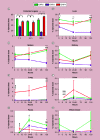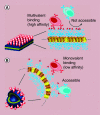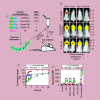Influences of nanocarrier morphology on therapeutic immunomodulation
- PMID: 30084296
- PMCID: PMC7270889
- DOI: 10.2217/nnm-2018-0052
Influences of nanocarrier morphology on therapeutic immunomodulation
Abstract
Nanomaterials provide numerous advantages for the administration of therapeutics, particularly as carriers of immunomodulatory agents targeting specific immune cell populations during immunotherapy. While the physicochemical characteristics of nanocarriers have long been linked to their therapeutic efficacy and applications, focus has primarily been placed on assessing influences of size and surface chemistry. In addition to these materials properties, the nanostructure morphology, in other words, shape and aspect ratio, has emerged as an equally important feature of nanocarriers that can dictate mechanisms of endocytosis, biodistribution and degree of cytotoxicity. In this review, we will highlight how the morphological features of nanostructures influence the immune responses elicited during therapeutic immunomodulation.
Keywords: antigen-presenting cells; biodistribution; drug delivery; immunomodulation; immunotherapy; nanocarrier; nanomaterial; nanoparticle; theranostics; vaccination.
Conflict of interest statement
The authors have no relevant affiliations or financial involvement with any organization or entity with a financial interest in or financial conflict with the subject matter or materials discussed in the manuscript. This includes employment, consultancies, honoraria, stock ownership or options, expert testimony, grants or patents received or pending, or royalties. This work was supported by the National Science Foundation grant 1453576 and the National Institutes of Health Director's New Innovator Award no. 1DP2HL132390-01.
No writing assistance was utilized in the production of this manuscript.
Figures





References
-
- Kaufman J, Völk H, Wallny HJ. A “minimal essential Mhc” and an “unrecognized Mhc”: two extremes in selection for polymorphism. Immunol. Rev. 1995;143:63–88. - PubMed
-
- Zimmerman LM, Vogel LA, Bowden RM. Understanding the vertebrate immune system: insights from the reptilian perspective. J. Exp. Biol. 2010;213(5):661–671. - PubMed
Grants and funding
LinkOut - more resources
Full Text Sources
Other Literature Sources
